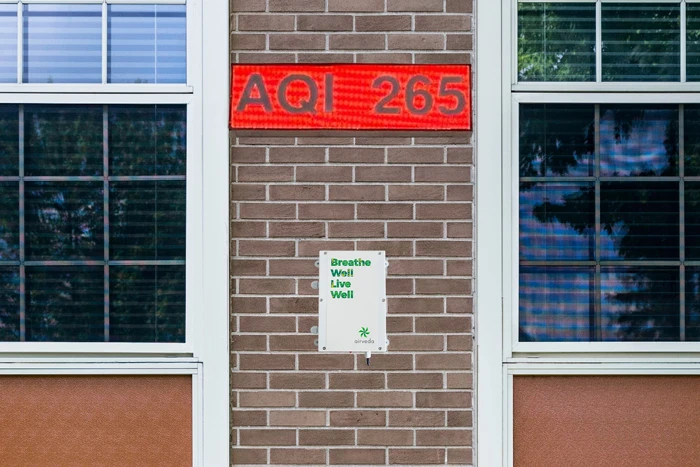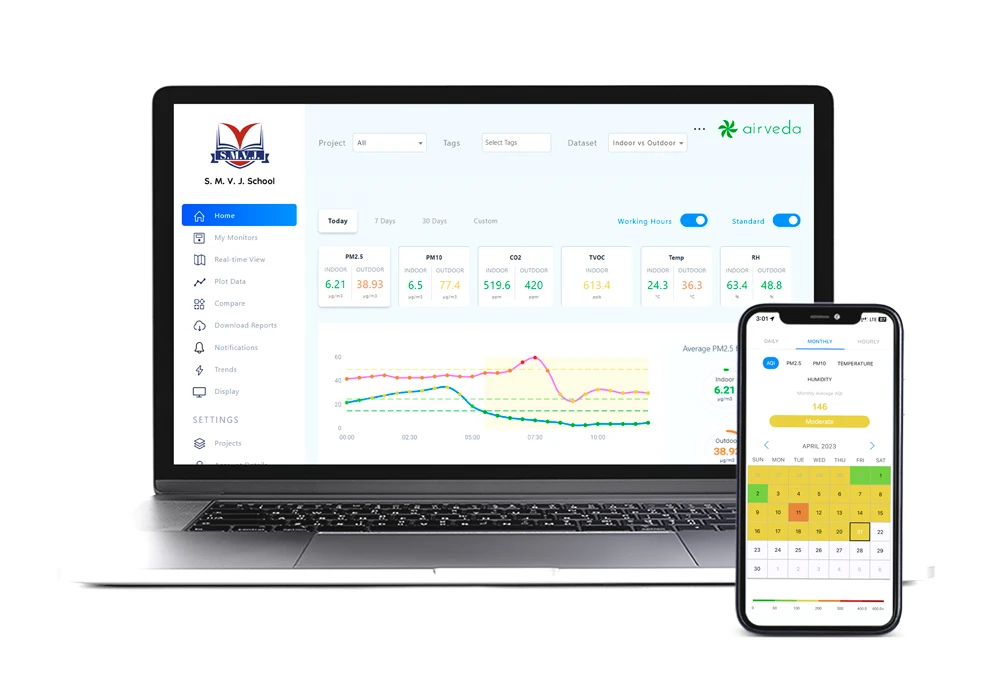Is your school safe? Here’s why air quality monitoring matters
In its 5th World Air Quality Report (2022), the World Health Organization (WHO) presented a few alarming facts:
- Air pollution in India is responsible for 1.2+ million deaths each year.
- Six Indian cities are part of the top 10 most polluted cities in the world.
- About 60% of our cities recorded annual PM2.5 levels that were 7 times higher than WHO’s prescribed limits.
But what do these numbers translate to in real terms, especially for one of the most vulnerable segments of our society—children? Here’s one parent’s account: Shruti Jolly, a resident of Delhi, shared with us the grave effect of poor air quality on her daughter, Avika. At a mere 6 months of age, she had the first of many wheezing attacks and was prescribed anti-allergy medicines and steroid-based inhalers.
In fact, Airveda’s genesis also stems from co-founder Namita Gupta taking matters into her own hands. As a mother to a young, asthmatic daughter, Namita wanted to manage her daughter’s exposure to air pollution. She realised that to help her child stay healthy, she needed to fix air quality not just at home, but everywhere, even if it meant building her own air quality monitor and convincing her daughter’s school to use one, just to understand how worrying the situation was.
Unfortunately, today, many parents have similar stories to share. And while deteriorating air quality is harmful for absolutely everyone, children are especially at risk.
Why are children at greater risk?
Apart from the elderly, children are at greater risk simply because their lungs are still developing. Additionally, many pollutants are at a high concentration closer to the ground. This means that children are prone to inhaling more quantities of such pollutants than the average adult.
What makes things worse is that children not only breathe a lot more rapidly than adults, but also breathe in more air. For example, an average adult takes 12–20 breaths per minute. On the other hand, children aged 3–5 years breathe 22–34 times, and those aged 5–12 years breathe 16–30 times per minute.

Combine this with the fact that children are a lot more active than adults, and that their immune systems are still developing (and therefore not strong enough), and it is clear why children are extremely vulnerable to the ill-effects of poor air quality.
Over time, prolonged exposure to air pollution can compromise lung growth, impair lung function, and result in health conditions such as asthma and bronchitis.
It's time for schools to step up
Schools are uniquely placed to drive change. Consider this: Children spend much of their time at school—upwards of 1,000 hours a year. What’s more, the infrastructure and location of most schools makes them susceptible to poor air quality. Let’s break it down:
- Most schools are located centrally, and therefore are surrounded by heavily-trafficked roads. Idling engines of school buses and cars alone spike air pollution levels considerably.
- Toxic chemicals are everywhere, from building materials and furnishings to art and science supplies.
- Swimming pools contribute to high levels of humidity and encourage growth of mould.
- Carpets in classrooms and auditoriums trap pollutants, toxins, and allergens, exacerbating their impact.
- Kitchens that cook meals for students also contribute to air pollution.
While every school may not be rife with problems, many are. And as parents and educators, it’s time to prioritize clean air.
Making air quality a priority
Since most schools don’t check air quality, improving it is difficult. After all, how do you solve something that you don’t measure? So, the logical first step in building a better learning environment is to invest in air quality monitoring systems —both indoor and outdoor.
Outdoor air quality monitoring

“Is it safe for students to play outdoors freely?”
“Do they need to wear a mask when playing outdoors?”
“Should they play indoors instead?”
Spending time outdoors is critical to the development of young minds, but only when the air is clean. By using air quality monitoring systems regularly, schools can:
- Take data-driven decisions that are in the best interest of children’s health. For instance, they can plan student activities based on the air quality trends of the day. Air quality tends to be worst in the mornings and the best around noon and afternoon, making it ideal for outdoor time, especially during the winters.
- Provide immediate guidance to students based on real-time AQI. For example, various schools use a flag system or AQI displays which showcase a red, yellow or green reading based on the prevalent air quality, and have clear instructions for students on appropriate actions. Red means no outdoor activities and wearing a mask when outdoors, yellow means limited outdoor activities, and green means unrestricted outdoor activities.

Indoor air quality monitoring

As per the United States Environmental Protection Agency, the level of air pollutants can be 2–5 times higher (on average) indoors than outdoors. In the Indian context, things like furnishings and upholstery, poor ventilation, lighting of incense sticks, and Volatile Organic Compounds (VOC) from room fresheners, cleaning products and disinfectants can make classrooms unsafe.
These pollutants can trigger serious health conditions such as nervous system disorders and in dire situations, even cancer.
Another major concern is rising carbon dioxide (CO2) levels. A large number of students—sometimes upwards of 30—spending hours together in a closed classroom can result in carbon dioxide levels rising. This is because exhaled air that gets trapped within the classroom is rich in CO2. Unfortunately, an excess of carbon dioxide can result in poorer concentration, cognition, and decision-making in addition to respiratory distress over time. And, while opening a window may seem like the simplest way to solve this problem, it isn’t. Given the state of air pollution today, it simply introduces more pollutants to the mix, thereby worsening the situation.
Lastly, especially in a post-COVID world, understanding how poor air quality can accelerate viral transmissions within classrooms is key. Lack of ventilation (and therefore high CO2 levels), improper air temperature, high humidty and the presence of PM2.5 particles all contribute to transmissions. They increase the atmospheric life of viruses as well as the viral load.
The bottom line? Particulate matter monitoring (PM2.5 and PM10), along with measurement of carbon dioxide, VOCs, temperature, and humidity levels must be non-negotiable. With the right air quality monitoring systems in place, as a school you can:
- Know just how effective your purification and ventilation systems are.
- Choose the right systems based on the pollutants that are found within your school (if you don’t have any such systems already).
- Enjoy the benefits of automation when it comes to managing air supply and purification. In turn, save energy, money and reduce your carbon footprint.
What’s more, as an educational institution you can reassure parents that your focus is holistic development and wellbeing of students by showcasing good air quality. You can also can integrate air quality management into your daily operations effortlessly. Data presented via mobile apps and web dashboards allows you to take timely decisions, on the go.

A continuous approach is critical
If you’re wondering whether your school really needs an always-on air quality monitoring system, the answer is a resounding yes. Just like your child’s performance in school on one day isn’t indicative of his/her performance over the course of a year, sporadic air quality testing or spot-checking, even when done with high-grade equipment, isn’t accurate or reliable. It paints a warped, imperfect picture.
This is why daily, weekly, and monthly air pollution monitoring is critical. You can study day-to-day variations as well as understand how air quality differs in the morning versus the afternoon. You can also check for patterns and trends, and as a result be better equipped for every eventuality.
Making a difference one school at a time
In 2018, WHO found that 93% of children under the age of 15—an astounding 1.8 billion—breathe poor quality air. Over the years, at Airveda, we have made it our mission to partner with schools to change this.

American International School of Dhaka, American Embassy School, The British School New Delhi, American School of Bombay, DSB International School, The Ardee School, Vasant Valley and Pathways are few of the many educational institutions that have benefitted from Airveda’s environmental monitoring systems.
They have been able to identify threats and take remedial action in time. For instance, a school built an indoor games arena that students could use when the air quality outdoors was hazardous. Similarly, another school minimised the impact of pollutants by defining protocol for students to follow, like wearing face masks when outdoors (based on certain thresholds).
On the whole, the growth in awareness has had a far-reaching impact. Today, parents are not only more cognizant of air quality exposure, but also factor in a school’s approach towards it when choosing one for their children. Similarly, schools that have put in place air quality monitoring systems have been able to position themselves better. They stand out to those parents who are not just looking for good education, but also seek a school that focuses on their children’s welfare in equal measure.

The time to act is now
Most businesses today take great pride in making data-driven decisions. It’s time for the same thought process to guide the way we look at schools. Whether you’re an educator or a parent, the need of the hour is using data and information to create healthy, safe learning environments, without escalating costs or amplifying one’s carbon footprint.
To take the first step towards this goal, we encourage you to contact our experts at Airveda. With a deep understanding of air quality and how it impacts health, we can help you create clean, pollution-free spaces where children are sure to thrive. Write to us at info@airveda.com to get started.

